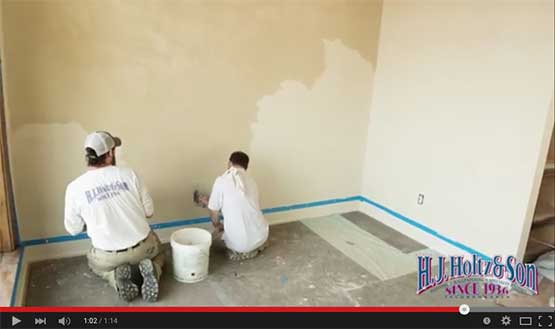The picture-perfect pool house, newly built on the historic Weyanoke Plantation in Charles City, Virginia, is a scenic waterfront getaway situated on a wide, grassy bend of the James River. A short distance from Sandy Fields Farm, the 1200 sq. ft. pool house features a panoramic view of the expansive property through tall windows that nearly reach from the floor to the ceiling. The doors facing the adjacent concrete diving pool swing open or slide into a recess in the wall, creating a space that’s both bright and truly open. At the center of the room is a kitchen with a large island and a wall of cabinets, which separates the single room from a back hallway that leads to two locker room-style bathrooms, complete with changing stalls.
The homeowners envisioned rich Venetian plaster adorning the interior walls of the kitchen and wrapping around the huge windows into the hallway, about 800 sq. ft. of wall space in total. Applying Venetian plaster requires trained craftsmanship above and beyond standard painting, so the homeowners hired H.J. Holtz & Son’s decorative artists to create the timeless look.
To achieve the Venetian plaster finish the customer desired, H.J. Holtz & Son foreman Jeff Ragland used Firenze Mineral Finish plaster in Marmorino KS, which contains sand and marble dust aggregates for a highly polished finish. “Marmorino,” which means “little marble,” dates back to Roman times. The material became very popular in Venice during the Renaissance period nearly 500 years ago, and is named for its ability to endure centuries of wear on the dank, canal-side exteriors of Italian buildings. Firenze, the manufacturer, maintains the historic “formula” by importing raw plaster from Italy to the U.S., where it can be tinted or matched to any color.
Before beginning the plaster process, the joints and seams of the walls had to be “skimmed” to achieve a level 5 drywall finish, which has a completely smooth and flat surface. If Venetian plaster is applied to an uneven surface, the burnishing process will create dark marks and unwanted texture on the raised areas. Next, the walls were primed using clear ISOSIL primer, which is suited for lime-based finishes such as plaster.
Applying Venetian plaster is a labor-intensive, two-coat process, Ragland said. First he applied the wet plaster material to the wall and burnished it with a stainless steel trowel as it set, scraping and spreading small gobs in an arc-shaped motion to smooth out any cracks. Shane Legano, a decorative artist assisting Ragland, followed behind to further smear the plaster across the surface of the wall. This creates the distinctive streaky texture and marbled shine, but because the process wears on the shoulders, Legano said that the decorative artists typically complete these projects in teams.
Once the second coat of plaster dried on the walls, the color had lightened by 50 to 70 percent. The marble dust aggregate makes the dried walls feel cool to the touch, with a shiny antiqued finish reminiscent of the “Old World.”
“It gives a different look than paint, and it’s been around for hundreds of years,” Ragland said. The lime-based material is mold resistant and allows moisture to easily evaporate, making it ideal for a damp location like a pool house. While plaster can be stained and damaged, it’s considered a lifetime finish that doesn’t require the upkeep of paint. Venetian plaster can withstand the test of time where acrylic or cement plasters would fail, making it one of the most durable and authentic veneer wall finishes available.
You can bring a traditional Renaissance feel to your space with Venetian plaster, skillfully applied by the experienced decorative artists of H.J. Holtz & Son. Call for an estimate today, or book a visit our new Richmond Design Studio to see the range of finish options we can create in your home.

